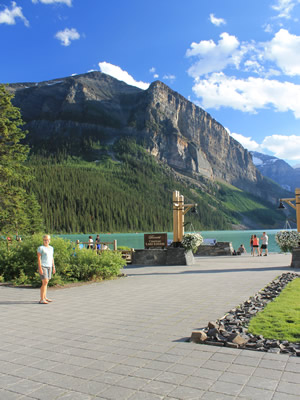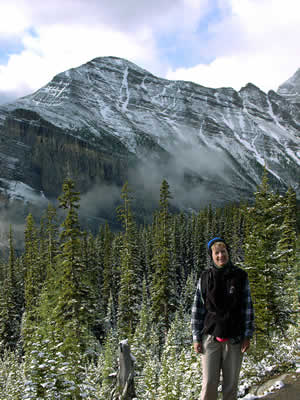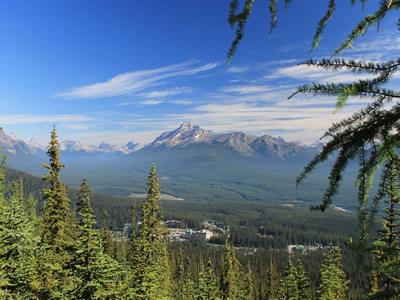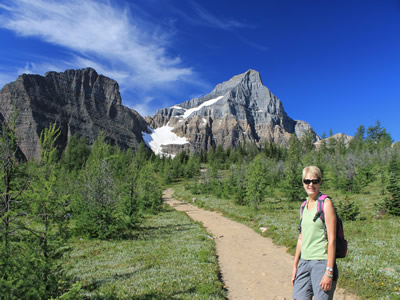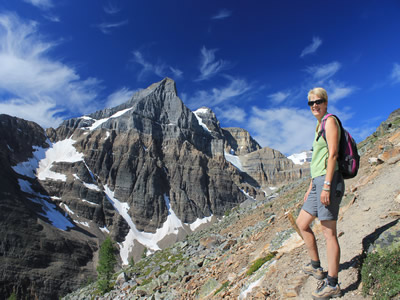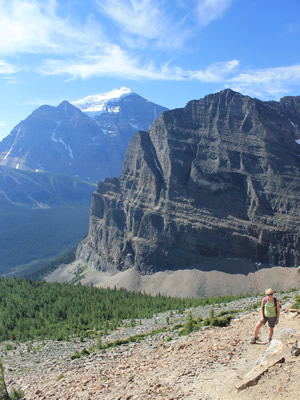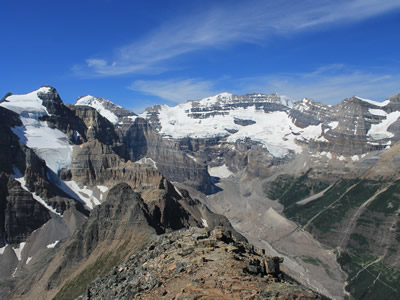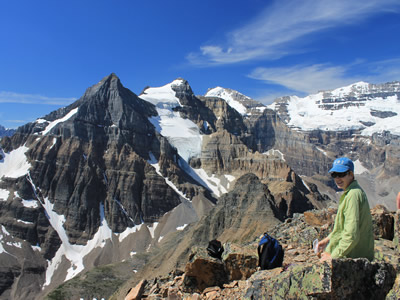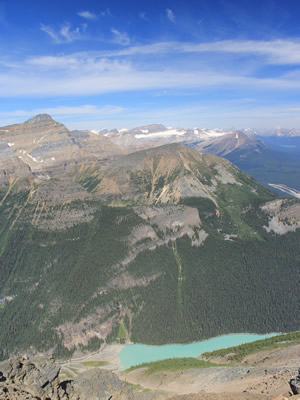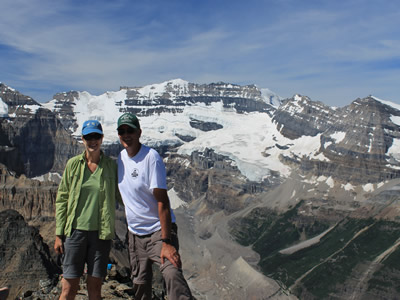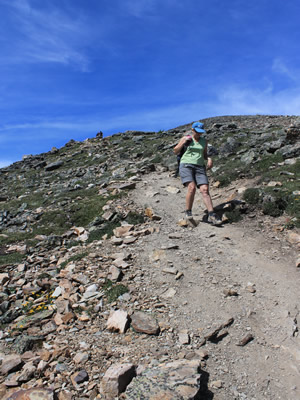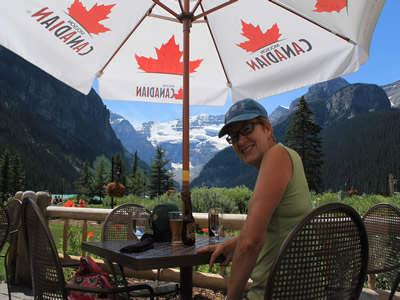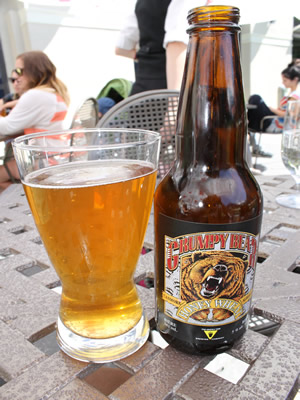Climbing Fairview Mountain
Fairview Mountain was at the top of the list of hikes that we wanted to do. At 9,003 feet it is an intermediate peak among the 11,000 foot giants of the Lake Louise area. But from the shore of Lake Louise it presents an impressive, steep cliff face that rises over 3200 feet to the summit. That alone would make it a worthy objective. Add in the fact that its position and intermediate elevation make it one of the best viewpoints in the area for seeing the famous peaks surrounding it and it's easy to understand why Fairview has been on my "To Do" list for a long time. We had hoped for a chance to get to the top on a previous visit in 2002. On that trip we were only at Lake Louise for two nights and hit a spell of bad weather - a Fourth of July snowstorm. That wasn't a good time to attempt an ambitious objective like Fairview Mountain. Back then we settled for the tamer hike to Lake Agnes, which gave us beautiful views of Fairview Mountain with a fresh dusting of summer snow. It made us even more anxious to try it when we came back on a future trip.
Fast forward eleven years to our current visit. As always, I never would have expected it to be so long before we were back. It's not that we hadn't been traveling. There are just too many exciting places to go. But now we were back and excited to give it a try. Since we had a whole week at Lake Louise I figured we were almost certain to get some good weather to make an attempt on the summit. So far on this trip the weather had been perfect. But now the forecast had changed and most days showed partly cloudy or chance of thunderstorms.
The one exception was the second day of our stay. The forecast predicted a perfect sunny day. The previous day we had done a hike to Stanley Glacier, saving our best weather day for Fairview Mountain. When I woke up the next morning and looked out our hotel window the weather was as promised - perfectly clear without a cloud in the sky. There was no uncertainty about what to do today. Along with the sunshine we would have unusually high temperatures, even in the mountains, so we wanted to get an early start. We had breakfast and drove to Lake Louise and easily found a parking spot. There was no sign of the usual crowds at 8:30 in the morning. After a quick photo session at the lakeshore to take advantage of the excellent early morning light, we started up the trail by 9am. That isn't what I usually think of as an alpine start but on this trip we rarely saw anyone on the trail until 10 am. A lot of people didn't even start until after noon. It's true that it stayed light until quite late but the afternoons had been very warm, even at higher elevations. We were at least early enough that we could do the hard work of gaining elevation in the cool of the morning rather than in the heat of the afternoon. And we would be down from the summit before any afternoon cloud build up could turn into a threatening thunderstorm. In the open, high on a mountain above timberline, is not where you want to be when a storm hits. We would have that adage reinforced on our hike the very next day.
One drawback to leaving early though was that we were usually the only ones on the trail. Normally that would be a bonus. Solitude is an important part of the wilderness experience when hiking in the mountains. I have done a lot of hiking by myself in remote places in the Sawtooth Wilderness in Idaho. But hiking in grizzly country is different, although in this case grizzly bears weren't our only consideration. Parks Canada had a cougar warning posted for all of the trails around Lake Louise, including Saddleback/Fairview Mountain, and the Shoreline/Six Glaciers trail that we would do later in the week. Cougars, sometimes called mountain lions or pumas, are pretty common in the mountains in the western US and Canada. They usually aren't much concern for hikers. They almost never attack people although they will sometimes attack dogs or very small children. In fact they are quite elusive. It is very rare to even see a cougar while hiking and if someone does it is usually just a glance before it vanishes. Generally they avoid people.
I've been hiking for forty years and have never seen a cougar once. But there had been two unusual cougar sigthings at Lake Louise about two weeks before we got there. In one case, a cougar had followed a pair of hikers on the Lake Agnes trail. That's very unusual behavior and not good. Although there are certainly cougars in the area they wouldn't usually be close to such a busy trail, nor would they remain close to humans for any length of time. So once again we had our bear spray with us and were alert as we hiked. Maybe the cougar would chase away all the grizzly bears.
Since Fairview Mountain rises directly from the shore of Lake Louise, the route to the top isn't long. But it is a lot of elevation gain - 3263 feet to be exact - almost exactly 1000 meters. There is a maintained trail to Saddleback Pass that gains about 2000 feet in 2.3 miles. That's short but steep. From the pass the trail drops over into Sheol Valley and eventually joins with the Paradise Valley trail. But beyond the pass the trail was restricted to groups of four or more because of bear activity. We didn't care because we were interested in the climbers track that climbed the last 1200 feet up a scree slope in a mile to reach the summit of Fairview. That's even steeper. Definitely a good workout.
The trail does indeed start right from the lakeshore near the boathouse. This early we had the trail all to ourselves. Of course we had only hiked a hundred yards or so before we reached the cougar warning sign. We kept climbing through the forest and even though it was a cool morning we quickly worked up a sweat. The trail was steep but not unreasonably so. But it was relentless. There were no level stretches to catch your breath. It seemed like each and every step was uphill. Although we were in the forest, after about three quarters of a mile we started to cross occasional avalanche chutes coming down from higher on Fairview Mountain. The openings provided views back to Chateau Lake Louise, Lake Louise Village where we were staying, the Bow Valley with the Trans Canada 1 highway, Lake Louise Ske area across the valley, and beautiful peaks in the distance such as Mt. Hector and Mt. Richardson.
At about a mile we reached a trail junction and we chose the steeper of the two trails on the right. We thought that the other trail might circle around and drop down into Paradise Valley. It turned out that the two trails joined up again in about a quarter of a mile. Instead of feeling dumb for taking the steeper trail we just thought it showed that we were tough. Of course on the way down we knew better and took the easier trail.
Eventually we came out of the forest. We had hiked 180 degrees around the mountain from our starting point north of it. Now we were approaching Saddleback, the low point in the south ridge, the saddle between Fairview Mountain and Saddle Mountain. We could see the impressive cliffs of Sheol Mountain and Haddo Peak beyond the pass.
At the pass itself the view was somewhat restricted. On the west side the forest came right up onto the pass. So when we actually reached Saddleback more of the view was blocked by trees than it was from below as we approached. That would have been a disappointment if Saddleback had been our goal. But we had done the two thousand feet of elevation gain in only an hour and a half. That's not a bad pace for a couple of old hikers. Since the bugs found us as soon as we stopped, we started up the final slopes after only a brief pause. We were determined to do some peakbagging.
From the pass, steep scree slopes rise to the north for 1200 feet to the top of Fairview Mountain. Countless boots have worn a track which quickly climbs above the trees and then heads straight up the scree. No switchbacks here. It's a climbers track, not a maintained trail. Climbing to the summit in only a mile, it was even steeper than the trail below leading up to Saddleback had been. We didn't mind. We just took it slowly.
As we climbed higher Mt. Temple came into view to the southwest. It's a massive mountain and at 11, 627 feet, it's the highest peak in the Lake Louise area. Some hikers also appeared on the pass below us. One guy was really moving fast. He even caught and passed us on the final slope. We didn't mind. As we approached the summit we could even see a couple of other people who had beat us to the top. They must have started out earlier than we did. It wasn't a race though. We made it to the top in an hour and five minutes from the pass. We felt pretty good about doing the last twelve hundred feet in sixty five minutes. That was good enough for us.
We were on top of the world! We found some comfortable rocks where we could sit down, rest, have a drink and a snack, and enjoy the superlative view. We spent over an hour on the summit. We had a superb view towards Mt. Victoria, Mt. Lefroy, and the other 11,000 foot peaks that provide the backdrop to Lake Louise. To the east we could see up and down the Bow Valley with innumerable mountains on the other side. Mt. Temple was a monster mountain looming to the south. Lake Louise was over three thousand feet below and only visible if you walked a short way to the north to peer down. There was a prominent plaque cautioning people not to try to take a short cut down the north side of Fairview Mountain to get back. Although the upper slopes are easy, it quickly turns into sheer cliffs that require technical climbing. Many people (not very smart ones) have needed to be rescued from the north slopes of Fairview Mountain because they thought it would be a shortcut down. It's a horrible noob mistake as any experienced hiker would rememeber the view of the north face of Fairview Mountain from the trailhead. It's clearly not the way to try to come down.
It was a beautiful day and the views were incredible. It was one of those summits where you wish you could stay forever. No matter how much time you spend on top, you start back down with a feeling of regret that you have to leave such a magical place.
When we reached the summit there were a couple of people there already. One group had been there way ahead of us. One guy had passed us on the summit slopes. But while we were there lots of other people made it to the top. It wasn't long before there must have been fifteen people there. Although wilderness solitude is great, sometimes it is fun to hang out with other hikers. We spent quite a bit of time talking to one group that included the guy who had passed us on the way up and the couple that he was hiking with. He lived in Calgary and did a lot of hiking in the area. I picked his brain for other good hikes in the area and for info about our Lake O'Hara hike that was coming up later in the week.
Of course, after a while, The Subject came up. Bear Bells.
Since we had started early in the morning when there were no other hikers around, I had been wearing our bear bell. But when we reached Saddleback the slope from there to the summit had been completely open. There were no bears in sight so I took off the bear bell before we started up the last stretch. That was a good thing because that meant that I could play innocent, instead of getting a personal put down like the day before.
I think it came up while we were talking about people who were inexperienced and foolish enough to try to get back to Lake Louise by going down the north side of the mountain. The lady said something along the lines of, you could spot them easily enough because they were usually dumb enough to be wearing bear bells. Since the group was from Calgary and hiked in the area a lot, I figured that this was a chance for me to learn why this was such a bad practice. I asked them to explain, since I "wasn't from around here", why it was such a bad idea.
The husband jumped in with the standard joke "They're just dinner bells". When asked to explain, he said that bears learn to associate the sound of bells with humans. That didn't make any sense to me. Everyone agrees that hikers should make lots of noise on the trail, by talking and yelling and singing and clapping. Certainly bears assoiciate those sounds with people. So why wouldn't bells help if they associate that sound with people too? I pointed that out to him, although I did it politely.
I know what you're thinking. That doesn't sound like me. But I was being good.
His next try was that bears didn't take notice of the sound of bells. He said that he heard there was a study where somebody tested bears and they ignored the sound of bells. Ok, that sounded a lot more scientific. Maybe there really was something to all this dissing of bear bells. So I let it go at that but resolved to check it out myself when we got back down.
Since then I have spent a lot of time researching the topic on the internet. There are a lot of articles, blogs and forum comments that mention such a study. When I finally tracked it down, the initial source seems to be a single newspaper article in the Achorage Daily News written in June 2000. The reporter had interviewed Tom Smith, a wildlife biologist and associate professor at Brigham Young University, who is a noted expert on bear behavior and bear/human interactions. In 1999 he was working for the US Geological Survey doing a different research project on bears in Katmai National Park, when he tried ringing bells at various distances from bears. He reported that they didn't pay any attention to the sound. Smith actually was surprised by this as he thought that since brown bears are naturally curious, they would be interested in an unfamiliar sound. Later he broke a pencil to simulate the sound of a snaping twig. The bears took note of that sound even at long distances. So there was some truth at the core of what the guy on top of Fairview Mountain had said.
But even in the original article Smith points out that while this was suggestive, it was not definitive. It was an informal study, done once, with one population of brown bears. Smith did not even publish the results. In the interview he explicitly said that he would not recommend against wearing bear bells based on his observarions.
I also saw a lot of references to a study of bear incidents in Glacier National Park in 1982, although I couldn't find the original report. That study found that bears had only charged humans who had not been wearing bear bells. Of course, that is correlation and not causation. Strangely that study never seems to be mentioned by people who are down on bear bells. The most surprising thing to me was just how little rigorous scientific study there has been of bear/human interaction given that incidents occur every year. Most advice seems to be based on anecdotal evidence or the experience of people who spend a lot of time in bear country.
Personally I think that when hikers look down on others who wear bear bells, it's a classic case of confirmation bias. People who are annoyed by bear bells have latched on to anything that even hints that they aren't effective and turned it into an urban legend. Or is that a wilderness legend? Bottom line is that when I hike in bear country, I clap and talk. But since I get tired of doing that all the time, I also wear a bear bell because it might have some positive effect. But since I am tired of being hassaled I don't wear them on busy trails.
And just for the record, for all those hikers who complain about how annoying bear bells are, I think that hikers who clap and talk loudly and sing all the time on the trail are at least as annoying as those who wear bear bells.
After all that discussion of bear bells, we still need to get our intrepid hikers down off the mountain!
The first section heading back down to Saddleback pass was tricky as the loose scree was tougher going down than going up. We took our time and tried to be very careful - a slip could mean nasty scraped elbows and knees. It had happened to me descending Mt. Nebo last fall. But once we reached the pass and real trail it was easy going. We still passed a surpring number of people heading up as we were going down. It was warm enough now that it didn't look like fun to be slowly slogging up the hill. We on the other hand could hear cheeseburgers calling us from the Chateau at Lake Louise and made fast time back to the trailhead.
We were able to get a table on the patio with a great view of Lake Louise and of Fairview Mountain. We ordered our burgers and Sandy tried a local brew, Grumpy Bear Ale, from a microbrewery in Canmore. She really liked it so we filed it away as someplace to visit if we ever had a rain day.
We stayed on the patio even longer than we had stayed on the summit. Good food, good weather, and a feeling of accomplishment. Sometimes looking back at a mountain you have just climbed is the best part of the whole day.
